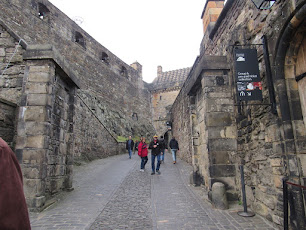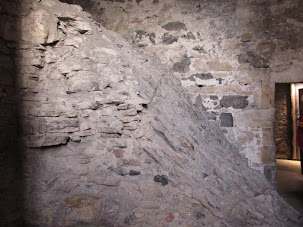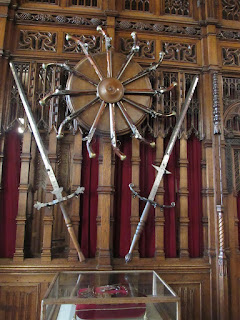
This little
stretch of the Irish Sea between Britain and Ireland became an important conduit to Ireland's history over the past 2,000 years.
This area was a region for trade that was even expanded to the Mediterranean Sea. Because
the Romans did not penetrate Ireland, trade flourished without fear of
their invasions. The Vikings did invade Ireland, however. The massive
network of Ireland's rivers and streams made it perfect for the
seafaring Vikings to establish settlements, which grew into towns and
cities. The Vikings inter-married with the native Irish, which made
the island a friendly and relatively peaceful place--until the 12th
century, the source of all Ireland's struggles that would last well into the 21st century.
These struggles began in 1170, about one hundred years after the Normans conquered England in 1066. The English began carve up Ireland to serve as gifts of land ownership to their loyal subjects. A patchwork of kingdoms emerged, and the Council of Kings was established.
Rory O'Connor, the landless king of Lancaster, attended the wedding of O'Rourke, king of the Griffin Kingdom. At the banquet after the wedding ceremony, the eyes of Rory and the newly-wed wife of O'Rourke met and they instantly fell in love. They started a passionate love affair until one night the new bride climbed out of the castle window and ran off to England with Rory. O'Rourke was aware of what had happened, and he asked the English king to help him bring back his wife without success.
Meanwhile, Rory wanted to earn the favor of the English king and regain the lands his father had lost in Ireland. He conquered several small kingdoms in Ireland, which he gave to the English king. For his reward, the king made Rory a member of the Irish aristocracy and gave him land. The English king also took control of Ireland.
When the Vikings established settlements, they wanted to create towns and cities. They were never in the countryside. Two different cultures emerged as a result: the Anglo city people and the Gaelic rural people. Moreover, when the Irish crossed into England, their language changed from Gaelic to English.
The Gaelic tribes never yielded to English rule or the language. When came the Protestant Reformation arrived, the towns and cities became Protestant while the people in the rural areas remained Catholic. Animosity between these two groups continued through the centuries until the 1919 when the home rule movement pressured England to grant Ireland independence. In 1922, the Republic of Ireland was established. Northern Ireland has remained a part of the United Kingdom, which also comprises England, Scotland, and Wales.
Two societies emerged in Ireland: the rural Gaelic and the city people. (The zone buffering these two societies was called "the pale", which is the origin of the expression "going beyond the pale".) The landed gentry descended from the Gaelic kings.
The 1700s and early 1800s was a very prosperous time for the Irish, and they had many modern amenities like gas lamps before most other countries did. Since the 1800s, Ireland has had the smallest of populations. When it joined the European Union in 1973, it became prosperous again and the fastest-growing country in Europe. Today, it welcomes immigrants, including the Ukrainians. The government is giving them work permits so they can get their lives back together.
Two thirds of the drivers in Ireland don't have licenses to drive. They never took a test; they just picked up driving.
Everyone here knows someone who knows someone.
Sailing the Irish Sea
The most dramatic part of our journey across the Irish Sea was the ferry boat ride from Scotland to Belfast, Northern Ireland. The huge boat accommodated our bus, cars, campers, and semi-trucks. Amazing! Passengers went to the top two decks to relax, watch movies, take a coffee, or order a meal or snack.


I spent the first hour of our two-hour ride with Caroline, a woman from Perth, Australia. We sat at the front of the boat and enjoyed the smooth ride across the sea. Then we split up and toured the boat on our own. I met some jolly young people who worked in the cafeteria, and we took some photos.
The seating area and the brightly-colored stairway make travel comfortable. Directions to the decks is easy and color-coded. A playroom for kids sported a giant screen for writing messages.


Driving in Scotland to the Ferry Boat
The drive from our hotel in Glasgow to the ferry boat was interesting in that we not only made tracks, but we saw how people lived. Their
houses are close together and their front yard consists of a parking
lot (dirt, gravel, or pavement) and maybe a small garden or a patch of lawn. The houses were simple,
one-story houses. Various renditions of this design were apparent in Ireland, Wales, and England as well.
We followed the western coast of Scotland, which would have been more interesting had the fog not blocked our vision. However, we passed through some small villages with a little history. Many of these villages were founded by the Vikings and dotted with many castles.
Prestwick, for example, is the only town in the UK Elvis ever set foot on. He was in the U.S. Army and his plane landed there for a brief layover.
Robert Burns (1759-96) was a Scottish poet and lyricist. He is one of the first to write in the Scottish language, however, he wrote his political commentaries in English.
We passed his birthplace in Alloway (just south of Ayr), a cottage that his father built. He was the oldest of seven children. There is a small museum there on him and his life.
Burns is regarded as a pioneer of the Romantic movement. Celebration of his life and work became almost a national cult during the 19th and 20th centuries and a cultural icon in Scotland and Scots throughout the world. In 2009 he was chosen as the greatest Scot by the Scottish public in a vote run by the Scottish television channel STV. He is seen to have been a major contributor to the Scottish identity.
Girvan has a
reputation as the most miserable town in all of Scotland, according to a
government survey. It was a fishing town that lost its industry through
treaty arrangements with the formation of the European Union. Different countries could specialize in different industries. France, for example, specializes in farming. The Brits lost their fishing industry. Meanwhile, the Greeks and other European fishermen, came to the UK waters and fished out the seas.
Girvan also lost its place as a vacation resort once people realized that Spain had warm, sunny weather as opposed to Girvan's rainy weather. The town has been dying for years and it continues through massive unemployment.
Trump Golf Course stands right on the shore of the Firth of Clyde. The clubhouse is a big white structure. Even though no one on the bus reacted to this news, our guide informed us that the golf course has employed a lot of people who were once part of the fishing industry. Trump's mother comes from this area.
Ailsa Craig is an island in the Firth of Clyde that sticks out even in the fog. Its shape is like a current bun, but its really a volcanic plug. Ailsa Craig (meaning “Fairy Rock” in Gaelic) is a place of history, folklore and legend with “sea monsters, smugglers, prisoners, dragons, cannibals."
At one time Ailsa Craig was a haven for smugglers of silk, spirits, and tobacco in the deep caves of its western side. Evidence also suggests that the Romans were here as well as the Catholic Spaniards who sought to invade Protestant Scotland. A three-story castle was built in the 1400s to ward them off, the ruins of which can still be seen today. The best granite stones come from here, granite stones for the sport of curling. Winston Churchill plotted the D-Day landing on the island, and General Dwight D. Eisenhower was given the top floor of the castle in gratitude for his leadership during World War II. No one lives on the island these days, but people are allowed to visit it.
Russian War Memorial to the crews lost on Russian convoys during World War I.
The Scottish Highlands
Big hills dominate the western coast of Scotland. The slopes are filled with little terraces. There are a lot of sheep (as there are everywhere we go on this tour) and hairy cows on green, green pastures. The houses and towns are built with rock. The brush hedges are orange-red at this time of year They grow in clumps like broccoli with green and yellow tops. Small streams of white water descends the hills and cliffs.
The hairy cows are called Highland Cattle. It is a hardy breed, able to withstand the intemperate conditions in the region. They are reared primarily for beef, and have been exported to several other countries.
The Scottish black-faced sheep are everywhere as well. They are bred principally for meat production. The wool is very coarse, with a fiber diameter of 28–38 μm and a staple length of about 250–350 mm. It is used for mattresses, for carpets, or to make tweed.
Resources
Andrew Speed, guide of CostSaver Travel Company
Robert Burns -- https://en.wikipedia.org/wiki/Robert_Burns#Alloway





























































